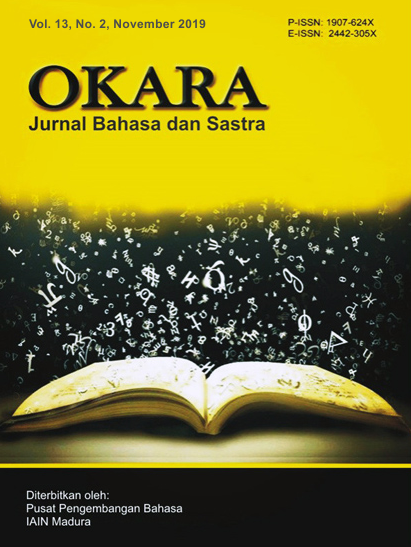Do I Talk Too Much in Class? A Quantitative Analysis of ESL Classroom Interaction
 Abstract views: 1263
,
Abstract views: 1263
,
 PDF downloads: 788
PDF downloads: 788
Abstract
Teacher-learner interaction in the classroom is dictated by how well the teacher manages classroom talk-time which has a direct influence on learner achievement in an ESL Classroom. Teachers often perceive that they allocate enough time for student talk time; however, the past literature suggests that teacher talk-time takes around 70-75% of overall time in the class. The purpose of this study is to analyze the TTT (Teacher Talk-Time) in the context of ESL classroom in Pakistan. Convenience based sampling was used to assess the Teacher Talk-Time through observational method. Findings of 12 sessions (30-hours) showed that average Teacher Talk-Time was 65% of the total classroom time. The study highlights that ESL teachers need to improve the Learner Talk-Time (LTT) as the analysis showed that on average each student only gets 22 seconds of talk-time in an ESL class. A blended learning model can help ESL teachers to eliminate some of the talk-time and engage learners with meaningful activities that encourage classroom interaction in the target language.
Downloads
References
Aisyah, Nurul. “An Analysis of Teachers’ Talk in an EFL Classroom.” Journal of English and Education 4, no. 2 (December 31, 2016): 63–79.
Asmari, AbdulRahman Awadh Al. “Communicative Language Teaching in EFL University Context: Challenges for Teachers.” Journal of Language Teaching and Research 6, no. 5 (September 4, 2015): 976–84. https://doi.org/10.17507/jltr.0605.09.
Blanchette, Judith. “Characteristics of Teacher Talk and Learner Talk in the Online Learning Environment.” Language and Education 23, no. 5 (August 18, 2009): 391–407. https://doi.org/10.1080/09500780802691736.
Cadorath, Jill, and Simon Harris. “Unplanned Classroom Language and Teacher Training.” ELT Journal 52, no. 3 (July 1, 1998): 188–96. https://doi.org/10.1093/elt/52.3.188.
Cameron, Lynne, Jayne Moon, and Martin Bygate. “Language Development of Bilingual Pupils in the Mainstream : How Do Pupils and Teachers Use Language?” Language and Education 10, no. 4 (November 1, 1996): 221–36. https://doi.org/10.1080/09500789608666710.
Chaudron, Craig. Second Language Classrooms: Research on Teaching and Learning. Cambridge: Cambridge University Press, 1988.
Chung, Siaw-Fong. “A Communicative Approach to Teaching Grammar: Theory and Practice.” The English Teacher 34, (March 21, 2015): 18.
Cullen, Richard. “Teacher Talk and the Classroom Context.” ELT Journal 52, no. 3 (July 1, 1998): 179–87. https://doi.org/10.1093/elt/52.3.179.
Doman, Evelyn. “The Flipped Classroom in Promoting Student Achievement.” English Australia Journal 33, no. 2 (2018): 62.
Farooq, Muhammad U. “Creating a Communicative Language Teaching Environment for Improving Students’ Communicative Competence at EFL/EAP University Level.” International Education Studies 8, no. 4 (2015): 179–91.
Jing, Nana, and Junrui Jing. “Teacher Talk in an EFL Classroom: A Pilot Study.” Theory and Practice in Language Studies 8, no. 3 (March 1, 2018): 320–24. https://doi.org/10.17507/tpls.0803.07.
Lei, Xuelian. “Communicative Teacher Talk in the English Classroom.” English Language Teaching 2, no. 1 (March 2009): 75–79.
Matsuda, Aya, and Patricia Friedrich. “English as an International Language: A Curriculum Blueprint.” World Englishes 30, no. 3 (2011): 332–44. https://doi.org/10.1111/j.1467-971X.2011.01717.x.
Mercer, Neil. “The Seeds of Time: Why Classroom Dialogue Needs a Temporal Analysis.” Journal of the Learning Sciences 17, no. 1 (February 15, 2008): 33–59. https://doi.org/10.1080/10508400701793182.
Nisa, Sinta Hoerun. “Classroom Interaction Analysis in Indonesian EFL Speaking Class.” English Review: Journal of English Education 2, no. 2 (April 3, 2015): 124–32.
Nurpahmi, Sitti. “Teacher Talk in Classroom Interaction.” Eternal (English, Teaching, Learning, and Research Journal) 3, no. 1 (June 30, 2017): 34–43. https://doi.org/10.24252/Eternal.V31.2017.A4.
Richards, Jack C. “Curriculum Approaches in Language Teaching: Forward, Central, and Backward Design.” RELC Journal 44, no. 1 (April 1, 2013): 5–33. https://doi.org/10.1177/0033688212473293.
Setiawati, Liani. “A Descriptive Study on The Teacher Talk at EYL Classroom.” Indonesian Journal of Applied Linguistics 1, no. 2 (January 5, 2012): 33–48. https://doi.org/10.17509/ijal.v1i2.83.
Svalberg, Agneta M.-L. “Researching Language Engagement; Current Trends and Future Directions.” Language Awareness 27, no. 1–2 (April 3, 2018): 21–39. https://doi.org/10.1080/09658416.2017.1406490.
Thompson, Geoff. “Some Misconceptions about Communicative Language Teaching.” ELT Journal 50, no. 1 (January 1, 1996): 9–15. https://doi.org/10.1093/elt/50.1.9.
Thornbury, Scott. “Teachers Research Teacher Talk.” ELT Journal 50, no. 4 (October 1, 1996): 279–89. https://doi.org/10.1093/elt/50.4.279.
Walsh, Steve. “Construction or Obstruction: Teacher Talk and Learner Involvement in the EFL Classroom.” Language Teaching Research 6, no. 1 (January 1, 2002): 3–23. https://doi.org/10.1191/1362168802lr095oa.
Woodall, Tony, Alex Hiller, and Sheilagh Resnick. “Making Sense of Higher Education: Students as Consumers and the Value of the University Experience.” Studies in Higher Education 39, no. 1 (January 2, 2014): 48–67. https://doi.org/10.1080/03075079.2011.648373.
The journal operates an Open Access policy under a Creative Commons Attribution-NonCommercial 4.0 International License. Authors who publish with this journal agree to the following terms:
- Authors retain copyright and grant the journal right of first publication with the work simultaneously licensed under a Creative Commons Attribution License that allows others to share the work with an acknowledgement of the work's authorship and initial publication in this journal.
- Authors are able to enter into separate, additional contractual arrangements for the non-exclusive distribution of the journal's published version of the work (e.g., post it to an institutional repository or publish it in a book), with an acknowledgement of its initial publication in this journal.
- Authors are permitted and encouraged to post their work online (e.g., in institutional repositories or on their website) prior to and during the submission process, as it can lead to productive exchanges, as well as earlier and greater citation of published work.





_(1).png)
.png)
.png)
1.png)
.png)
.png)

.png)
_-_Copy_-_Copy.png)





